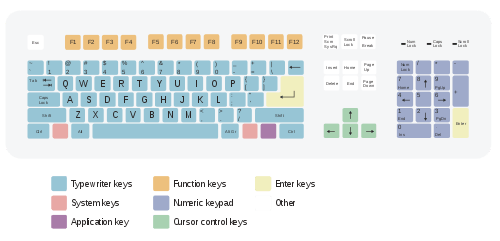Numeric keypad
A numeric keypad, number pad, numpad, or ten key,[1][2][3] is the palm-sized, 17-key section of a standard computer keyboard, usually on the far right. It provides calculator-style efficiency for entering numbers. The idea of a 10-key number pad cluster was originally introduced by Tadao Kashio, the developer of Casio electronic calculators.

The numpad's keys are digits 0 to 9, + (addition), - (subtraction), * (multiplication) and / (division) symbols, . (decimal point), Num Lock, and ↵ Enter keys.[4] Laptop keyboards often do not have a numpad, but may provide numpad input by holding a modifier key (typically labelled Fn) and operating keys on the standard keyboard. Particularly large laptops (typically those with a 15.6 inch screen or larger) may have space for a real numpad, and many companies sell separate numpads which connect to the host laptop by a USB connection (many of these also add an additional spacebar off to the side of the zero where the thumb is located, as well as an additional 00 key typical of modern adding machines and cash registers).
Sometimes it is necessary to distinguish between a key on the numpad and an equivalent key elsewhere on the keyboard. For example, depending on the software in use,[lower-alpha 1] pressing the numpad's 0 key may produce different results than pressing the alphanumeric 0 key.[lower-alpha 2] In such cases, the numpad-specific key may be indicated as e.g. Numpad 0, NumPad0 [lower-alpha 3], Num 0, or likewise to remove ambiguity.
Numeric keypads usually operate in two modes. When Num Lock is off, keys 8, 6, 2, and 4 act like arrow/navigation keys up, right, down, and left; and 7, 9, 3, and 1 act like Home, PgUp, PgDn, and End, respectively. When Num Lock is on, digit keys produce the corresponding digit. On Apple Macintosh computers, which lack a Num Lock key, the numeric keypad always produces only numbers; the Num Lock key is replaced by the Clear key.
The arrangement of digits on numeric keypads with the 7-8-9 keys two rows above the 1-2-3 keys is derived from calculators and cash registers. It is notably different from the layout of telephone Touch-Tone keypads which have the 1-2-3 keys on top and 7-8-9 keys on the third row.
Numeric keypads are useful for entering long sequences of numbers quickly, for example in spreadsheets, financial/accounting programs, and calculators. Input in this style is similar to a calculator or adding machine.
A numpad is also useful on Windows PCs for typing alt codes for special symbols, for example the degree symbol, °, with Alt+0176. Technically the previous example's method using a leading 0 (ANSI alt code) only works when used with the numpad's own keys, so it could be written less ambiguously (if necessary) using one of the notations mentioned above, e.g. Alt+Numpad 0Numpad 1Numpad 7Numpad 6. When entering a hex Unicode value, only the leading '+' needs to be the Numpad + key, so this notation can be used sparingly, e.g. Alt+Numpad +11b yields ě.[lower-alpha 4]
Measuring speed
Ten key speed is measured in Keystrokes per Hour (KPH). The minimum required speed for many data entry jobs is around 9000 KPH with good accuracy. A speed of 12,000 is considered excellent.
Chinese input methods
The numeric keypad is used by some systems for input of Chinese characters, for example CKC Chinese Input System and Q9 input method.
Computer games
Numeric keypads are also used for playing some computer games where the player must control a character, for example roguelikes. Unlike arrow keys, the numeric keypad allows diagonal movement. For keyboards without a numeric keypad, some games provide alternative movement keys, such as classic Rogue's HJKL keys.
The numeric keypad can also be an alternative to the WASD keys for navigation in computer gaming. This can be an attractive option for left-handed people who prefer to use the mouse with their left hand.
See also
Notes
- E.g. Blender makes specific use of numpad keys for several keyboard shortcuts.
- I.e. the 0 key above the letter keys and to the right of the 9 key on a typical QWERTY keyboard.
- E.g. as defined in C#'s
System.ConsoleKeyenumeration:[5]106 NumPad0 = 0x60, 107 NumPad1 = 0x61, 108 NumPad2 = 0x62, 109 NumPad3 = 0x63, 110 ...
- Some applications (such as Firefox) will interpret hex numpad alt codes using letters a–f as user-interface commands, e.g. to open a menu.
References
- "What Is a Ten Key? (with pictures)". WiseGeek. Retrieved 8 January 2014.
- Pasewark, William Robert; Knowlton, Todd (1995-01-01). Ten-Key Skill Builder for Computers. South-Western Educational Pub. ISBN 9780538629195.
- Stroman, James; Wilson, Kevin; Wauson, Jennifer (2011-09-01). Administrative Assistant's and Secretary's Handbook. AMACOM Div American Mgmt Assn. p. 224. ISBN 9780814417607.
- numeric keypad at FOLDOC
- Microsoft (23 May 2019) [2014]. "mscorlib/system/consolekey.cs". Microsoft/ReferenceSource repository. GitHub. At line 106. Retrieved 24 June 2019.
| Wikimedia Commons has media related to Numeric keypads. |
| Esc | F1 | F2 | F3 | F4 | F5 | F6 | F7 | F8 | F9 | F10 | F11 | F12 | PrtScn/ SysRq |
Scroll Lock |
Pause/ Break |
|||||||||
 |
Insert | Home | PgUp | Num Lock |
∕ | ∗ | − | |||||||||||||||||
| Delete | End | PgDn | 7 | 8 | 9 | + | ||||||||||||||||||
| 4 | 5 | 6 | ||||||||||||||||||||||
| ↑ | 1 | 2 | 3 | Enter | ||||||||||||||||||||
| ← | ↓ | → | 0 Ins |
. Del | ||||||||||||||||||||
